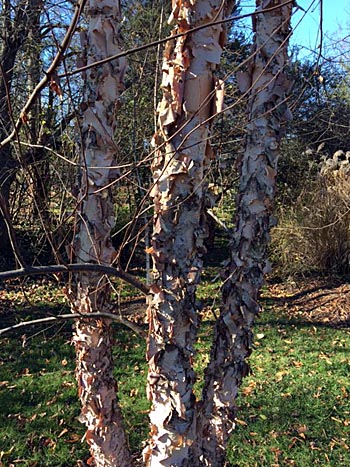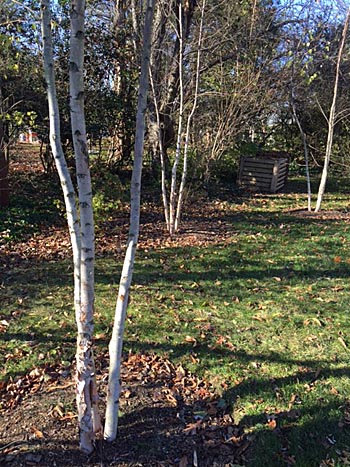Betula nigra, The Long-lived and Lovely River Birch
By Gretchen Spencer, Fairfax Master Gardener

River Birch ‘Heritage’
River birches are adaptable to a range of soil conditions. While they prefer soils that are moist and acidic, they will adapt to drier conditions. They also will grow in heavy clay soil. In their native habitat, they can be found growing along streams, in flood plains, and in swampy areas. River birches can also tolerate heat and drought, although they may drop their leaves early in drought conditions. Watering deeply and providing a layer of mulch are beneficial in these conditions. A river birch will grow in full sun to part shade.
The river birch grows about 40 to 80 feet high and 40 to 60 feet wide. There are both multi-stemmed and single-stemmed varieties. The glossy, 2- to 3-inch leaves are irregularly oval with doubly toothed margins. They turn yellow in the fall. A river birch bears both male and female flowers. The male catkins appear on the ends of the twigs in the fall and mature in the spring. The female seed-producing catkins appear with the leaves and mature in the late spring or summer.
The branches on our ‘Heritage’ birch are lightweight and arching, giving the tree an elegant appearance. The “rich, cinnamon-brown exfoliating bark,” according to Michael Dirr, makes the tree more spectacular without its leaves, when the bark is more visible. However, our large multi-stemmed ‘Heritage’ birch, in my opinion, is most beautiful when its leaves and arching branches sway in a breeze or light wind, the salmon-colored bark contrasting with the rich green of the leaves.
Importantly, the river birch is a native tree. According to Douglas Tallamy, author of Bringing Nature Home, birches provide food for a variety of wildlife, including several hundred species of moths and butterflies. Songbirds and small mammals eat their seeds and flower buds, and the exfoliating bark provides winter hiding places for insects, which in turn may be eaten by hungry woodpeckers.

River birch ‘Dura-Heat’
There are some 40 species of birches, all small to medium-sized trees. While the native white-barked paper or canoe birch, Betula papyrifera, or the European white birch, Betula pendula, may be the most well-known of the birches, prized for their white peeling bark, the former prefers cooler climates and the latter is highly susceptible to the bronze birch borer. The river birch is the most heat tolerant of all the birches, and the birch borer does not bother it.
If you are looking for a small to medium-sized tree to plant and enjoy in all seasons, one that is native and beneficial to wildlife, tolerant of wet soil, resistant to deer, and fast growing, consider the river birch. Then you, too, can sing its praises!
References
• Betula nigra, Missouri Botanical Garden
• Bringing Nature Home, How You Can Sustain Wildlife with Native Plants, Douglas W. Tallamy, 2007
• Dirr’s Encyclopedia of Trees and Shrubs, Michael A. Dirr, 2011
• The International Book of Trees, A Guide and Tribute to the Trees of Our Forests and Gardens,
Hugh Johnson, 1973
• Landscape Plants Rated by Deer Resistance, Rutgers Cooperative Research & Extension, Rutgers, The State
University of New Jersey
• River Birch, Arbor Day Foundation
• River Birch, Betula nigra, Virginia Cooperative Extension, Hort-23
• Trees of North America, A Field Guide to the Major Native and Introduced Species North of Mexico,
C. Frank Brockman, 1968